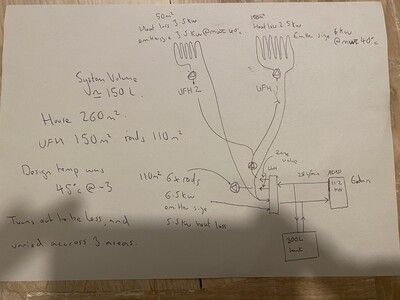@sunandair my graphs look similar on my ecodan. And when you make it 2 defrost and hour...... you can see how they struggle
Posted by: @davidnolan22I was having big trouble with defrosts and recovery from them, which is a little better now I've stopped asking for LWT that my system can't get to. But the recovery from defrosts is a struggle. My installer put in a bigger volume low loss header and zone values off them to try (I think) to stop the secondary circuits being open with defrost. But this has done nothing other than give me a small blending problem at the header than I didn't have before. The secondary circuits keep pumping during defrosts. My heat loss is about 11k at -3. I think my system volume is about 150L. with my generally low flow temps, do you think there is a case for more system volume. On another forum, I've been advised that 300L of system volume may help defrost.
Or, defrost are just part an parcel of a heat pump, deal with it, and 150L is still plenty for an 11.2KW ecodan even at 30 degree flow temps.
If your heat loss is 11kW and your heat pump is struggling to meet that (what is the actual heat output at 0C to -2C?), then the system may well struggle to recover from defrosts. This would be more a symptom of an undersized heat pump than a lack of volume, but a larger volume may help as there will be a larger store of heat for the defrost to call upon and consequently less impact on the system.
Have a look at the published data for maximum heat output for your heat pump under defrost conditions. If it cannot meet the demand then that is your issue.
Samsung 12kW gen6 ASHP with 50L volumiser and all new large radiators. 7.2kWp solar (south facing), Tesla PW3 (13.5kW)
Solar generation completely offsets ASHP usage annually. We no longer burn ~1600L of kerosene annually.
Posted by: @davidnolan22
Hi James,
on this topic: you've given good advice to me in the past and I'm working through things with my heat pump set up with the help of my installer. There have been some design issues, but I'm slowly getting to grips with it.
Running my system totally open and constant has helped a lot. I've got a mix of UFH ground floor and rads upstairs. (Ecodan 11.2Kw). But the design temperatures were meant to be the same as we have no mixing valves, but they are not. I can run the UFH system with really quite low temps. when its around freezing an LWT of 33 keep those rooms to a lovely temp of 20. The bedrooms above are about 17, which I think I'll just have to live with as I'm not putting more rads on the walls.
Firstly thank you for the feedback, its always good to get.
The only way I can see you could balance the temperatures would be to throttle the UFH. This will push up the required LWT so will increase cost, but perhaps not by too much in return for the additional comfort. Do check that all your upstairs rads arent throttled (some may be but the majority probably dont need to be).
Posted by: @davidnolan22I was having big trouble with defrosts and recovery from them, which is a little better now I've stopped asking for LWT that my system can't get to. But the recovery from defrosts is a struggle. My installer put in a bigger volume low loss header and zone values off them to try (I think) to stop the secondary circuits being open with defrost. But this has done nothing other than give me a small blending problem at the header than I didn't have before. The secondary circuits keep pumping during defrosts. My heat loss is about 11k at -3. I think my system volume is about 150L. with my generally low flow temps, do you think there is a case for more system volume. On another forum, I've been advised that 300L of system volume may help defrost.
Or, defrost are just part an parcel of a heat pump, deal with it, and 150L is still plenty for an 11.2KW ecodan even at 30 degree flow temps.
Defrost is part and parcel of a heat pump, so expect it. The issue arises if its taking too long and worse still if it doesnt complete, which will case the heat pump to lock up (In another thread locking up happens to someone when they have a bath and its cold outside). So if its not causing an insuperable problem, probably just leave it.
That said, what your installer has done is pretty much the exact opposite of what I would have done! I think the problem you have is that an LWT of 33 is quite low, and presumably its a bit lower still when the temp is above freezing. So the amount of energy available from the system to 'fuel' defrost is correspondingly low. I also suspect that much or part of it isnt reaching the heat pump during defrost because of the zone valves (please delete them or force them permanently open) and/or the LLH.
I can see two possible options if just forcing open the zone valves doesnt fix it:
1. Simplify the system - delete zone valves, secondary pump and LLH. This will ensure that the full system volume is available for defrost and also eliminate any mixing, improving COP
2. Add a volumiser on the heat pump side of the LLH to provide additional water for defrost
The first is obviously major surgery, but (unless there was a sound reason for the LLH in the first place) makes for a more efficient system where faults are easier to diagnose. Its just possible that, if you do this, you will still need a volumiser (repurpose the LLH for this!)
Hope that gives you some food for thought. There are some other options but they get more complex.
4kW peak of solar PV since 2011; EV and a 1930s house which has been partially renovated to improve its efficiency. 7kW Vaillant heat pump.
@sunandair sure, happy to make a sketch. I think I have done one somewhere but I’ll try to do a prettier one.
I think my system is working generally ok, but it’s been a bit out a journey this winter. Am I’m still so active with it learning how it reacts. so hoping to set and forget soon.
Posted by: @sunandairAlso it’s interesting to see how @johnr and the buffer tank he has fitted reacts to a defrost.
I should add that my system has two circulating pumps: One in the heat pump which circulates water to the buffer tank and DHW cylinder and one in the circuit to the radiators. Is there sufficient energy in a 10C drop in the 50 litre buffer tank temperature to melt the ice? If so, I would expect the pump in the radiator circuit to shut down until the buffer tank gets back up to temperature. I would need to buy two more of these temperature loggers to be able to monitor what's happening in that circuit during the defrosting. However, it appears to me that the much-maligned buffer tank does have its uses.
Further to the above I have just made some observations during a defrost cycle. My Arotherm+ kept the secondary (radiator) circuit pump running so the temperature in the flow to the radiators did drop by about half the drop in the temperature of the flow from the heat pump. The radiators, however, have sufficient thermal mass that they didn't go cold.
Posted by: @johnrHowever, it appears to me that the much-maligned buffer tank does have its uses.
There is absolutely nothing wrong with buffer tanks in principle. The problem lies with the execution which all too frequently, it seems, involves poorly balanced primary/secondary pumps resulting in excessive mixing and thus a reduction in overall system efficiency. They also make diagnosis of some problems more difficult.
A volumiser will do essentially the same job for defrost or reducing the frequency of cycling and cant suffer these problems. There are few if any domestic situations where the hydronic separation provided by a buffer tank (but not by a volumiser) is necessary. Hence the argument against buffer tanks in practice, given the wholly avoidable risk to the quality of the installation.
The irony is that those installers who are least likely to fit buffer tanks are most probably the very same installers who, if they fitted them at all, would fit them properly (and vice versa).
4kW peak of solar PV since 2011; EV and a 1930s house which has been partially renovated to improve its efficiency. 7kW Vaillant heat pump.
Can I ask a very simple question? The answer may be in this discussion somewhere so apologies if I have missed it...
When the heat pump goes into a defrost cycle, is the flow of water around the house actually reversed? Or is it just the heat pump refrigerant flow that is reversed?
The article states that "if the Volumiser is on the Return Side ... Cold water from defrost flows directly into the return pipe". But is this the case? Only if the direction of flow of the entire system is reversed.
Surely the heat pump itself will send flow the same direction whether the volumiser is on the flow or the return? Or am I missing something?
Posted by: @ccapCan I ask a very simple question? The answer may be in this discussion somewhere so apologies if I have missed it...
When the heat pump goes into a defrost cycle, is the flow of water around the house actually reversed? Or is it just the heat pump refrigerant flow that is reversed?
The flow doesn't get reversed but just keeps circulating without being heated at the heat pump. Consequently there's a drop in flow temperature as the water passes through the heat pump (to melt the ice) instead of a rise which results in the flow going into the house being colder than the flow going out of the house.
As I thought. So isn't the line "cold water from defrost flows directly into the return pipe" incorrect?
Not trying to be pedantic. Just trying to get my head around the whole subject. But this discussion on volumisers has confused me a little because it suggests that the heat pump will reverse the direction of flow of the whole system.
This whole "hot water from the primary is used in the defrost" is confusing me. Unless it is not general across all makes the Ecodan reverses the flow of hot refrigerant gas to defrost the evaporator after stopping the fan and primary flow pump.
Currently viewing this topic 4 guests.
- 26 Forums
- 2,335 Topics
- 52.6 K Posts
- 488 Online
- 5,990 Members
Join Us!
Podcast Picks
Latest Posts
-
RE: Replacing my 18 month old Hitachi Yutaki ASHP
It will be good then to see some plots tomorrow morning...
By JamesPa , 16 minutes ago
-
RE: A2A vs A2W: Which Heat Pump Would You Pick?
I have one fancoil in an otherwise all radiator system....
By JamesPa , 20 minutes ago
-
RE: Is your heat pump insured?
@davesoa Just following up on my original post, I am go...
By Richard24738 , 40 minutes ago
-
RE: How good is the app support for your heat pump?
I would describe the Vaillant app as pretty reasonable-...
By JamesPa , 2 hours ago
-

If the Solis inverter has a configuration setting label...
By Transparent , 2 hours ago
-

RE: Electricity price predictions
That's understandable...but I was referring to our 'oth...
By Transparent , 3 hours ago
-
@batpred Inwas looking at the Ånderson Wall Box, found ...
By AgentGeorge , 3 hours ago
-
RE: Solis S6-EH1P8K-L-PLUS – Why I Chose It and What I’ve Learned So Far
I'll be interested to see how you get on. Are ...
By Bash , 4 hours ago
-
RE: Battery with existing PV - regulations
We submitted our papers for SEG, so hopefully we will s...
By Batpred , 5 hours ago
-
RE: One Year Review: Grant 13kW ASHP - A Catalogue of Errors
@solenoid Its probably worth adding that, done well, g...
By JamesPa , 7 hours ago
-

RE: Solar panels on side of house to heat water
My solar panels (both PV and thermal) have not required...
By Transparent , 10 hours ago
-
RE: Rate the quality of your heat pump design and installation
@solenoid Welcome. I have made some commen...
By JamesPa , 13 hours ago
-
RE: Mitsubishi Ecodan 11kw Defrosting Issue.
@f1p Thanks for the info, good to know
By ThunderMink , 15 hours ago
-
@toodles I will do, it can’t go any worse than my last ...
By Grantmethestrength , 1 day ago
-
RE: Configuring third party dongle for Ecodan local control
Yes, it is certainly an advanced feature and quite diff...
By F1p , 1 day ago
-
RE: MELcloud scheduling misbehaviour
@richard24738 We also want hot water for 7:00am showers...
By DavidAlgarve , 1 day ago
-
RE: Havenwise App Help & Forum Support – Get the Most from Your Heat Pump
@hcas Thanks Henri. I take your point, but feel that wh...
By DavidAlgarve , 1 day ago
-
RE: Flow rate discrepancy between ASHP and manifold
Ok, I think I have got to the bottom of the problem... ...
By AshRolls , 1 day ago






